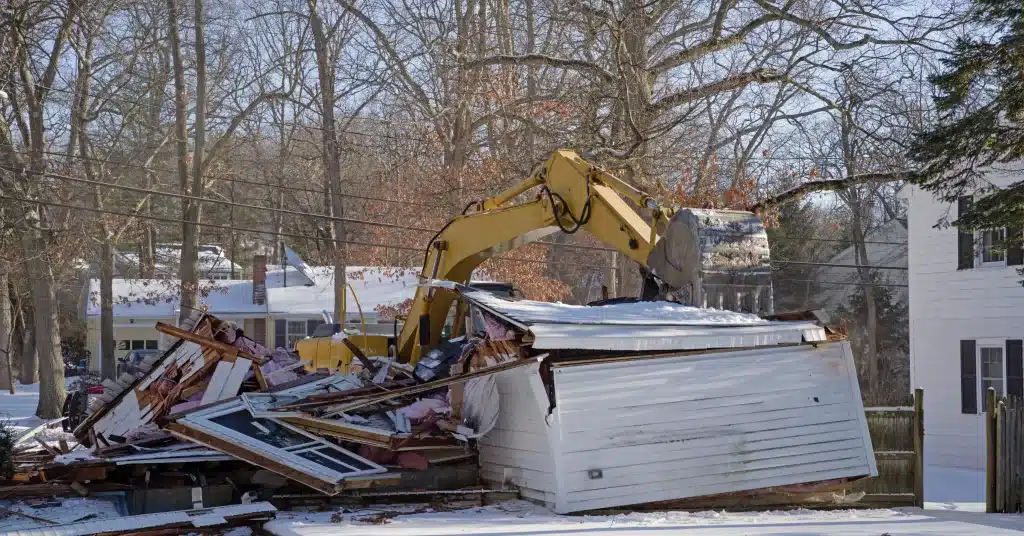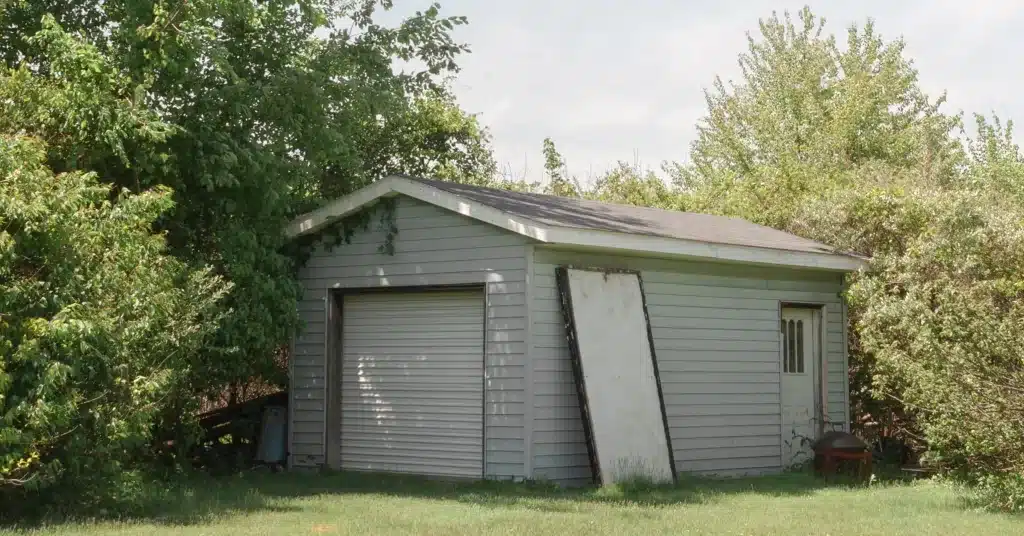How to Demolish a Shed Efficiently: Step-by-Step Guide
Taking down an old shed may seem challenging, but it’s a chance to clear space, freshen up your yard, and get rid of that worn-out structure. Whether it’s become a cluttered storage spot or just doesn’t suit your yard anymore, demolishing it can be satisfying.
In this guide, we’ll cover everything you need to know to safely and efficiently tear down a shed, from preparation and permits to tools, safety tips, and cleanup. By the end, you’ll be ready to tackle shed demolition and also remove leftover debris with confidence, turning that old shed space into a fresh, open area in your yard.
Preparation for Shed Removal and Demolition
Before you tear down your shed, you need to cover some groundwork. Preparation is key to making this project smooth, safe, and even enjoyable! Here’s what you need to know to get started.
Check Guidelines and Permits for Shed Demolition
First things first: don’t skip checking the local rules. Depending on where you live, you might need a permit to demolish a shed, especially if it’s on a larger property or has utilities connected.
Check with your local city or county office to see if it requires a permit; a quick call or online search can save you trouble later. Having the right permits ensures you can demolish them legally and avoid unexpected fees or issues.
Assess Electrical and Utility Connections
- Check for Electricity: Got any electricity running to the shed? Maybe a few lights or an outlet for tools? Before you start tearing anything down, make sure to disconnect any utilities connected to the shed.
- Turn Off the Main Power: Head to your main power box and switch off the power connected to the shed. This is a crucial step to ensure safety during demolition.
- Consider Calling an Electrician: If you’re uncomfortable handling this yourself, consider calling an electrician. This isn’t something to overlook—messing around with live wires can be dangerous and should be handled cautiously.
Gather Necessary Tools and Equipment
Now comes the fun part—tool time! As you gear up for your demolition project, you’ll need a few key items to make the job easier. Always have someone on-site for safety—it’s essential in case of an emergency. So grab a buddy or family member for a productive, no-alcohol bonding experience.
Tools Needed:
- Sledgehammer – For breaking down walls and roofing.
- Crowbar or Pry Bar – To help remove nails, boards, and other materials.
- Power Drill/Screwdriver – For unscrewing fasteners and taking apart framing.
- Reciprocating Saw – Ideal for cutting through wood, metal, and other tough materials. For best results, Diablo Saw Blades are a great choice—they cut efficiently and are durable.
- Ladder- To safely remove roofing materials and dismantle high sections.
- Shovel – To scoop up debris and manage cleanup.
- Wheelbarrow – Useful for hauling debris from the demolition area.
- Utility Knife – Handy for cutting through insulation, tar paper, and other materials.
- Trash Bags or Debris Bins – For easy removal and disposal of materials.
Safety Equipment:
- Hard Hat – To protect your head from falling debris. Having a partner with you during the demolition is also a must; having an extra set of eyes and hands can ensure the job goes smoothly and safely.
- Safety Goggles – To shield your eyes from dust and flying particles.
- Dust Mask or Respirator – Prevents inhalation of dust, mold, or other harmful particles.
- Heavy-Duty Gloves – Protect your hands from sharp objects, splinters, and debris.
- Long-Sleeve Shirt and Long Pants – Shields skin from scratches and insulation fibers.
- Sturdy Work Boots – Provides foot protection with a strong sole to prevent punctures.
Make sure everything is in good working order. You don’t want a drill giving out on you halfway through. With the right tools, you’re setting yourself up for a smooth demo job.
Step-by-Step Shed Demolition and Removal Process
Let’s get into the heart of the matter: tearing down that shed. With each step, we’ll keep safety first and efficiency a close second.
1. Take Safety Precautions First
Safety might not be the most exciting topic, but it’s non-negotiable here. Before you start swinging, suit up! Wear gloves to protect your hands, goggles for eye protection, and a dust mask if things get messy.
It’s also crucial to have a partner with you—dismantling a shed alone can be dangerous. Having someone by your side ensures you’re not tackling a potentially risky situation alone, especially with heavy materials that can collapse unexpectedly.
Take breaks when needed, stay hydrated (especially in the summer), and don’t push yourself too hard—it’s a shed, not a race.
2. Empty and Sort Shed Contents
Before you start the actual demolition, clear out everything inside the shed. Sort through items to decide what to keep, discard, or donate. Organize any tools, garden supplies, or other equipment and remove them from the work area. This step not only protects valuable items but also ensures a safe and clutter-free workspace for demolition.
3. Disassemble Shed Doors and Windows
- Safety Tip: When removing wood pieces, always use a hammer to bend down the nails—this is an OSHA requirement and helps prevent injuries. The side of the hammer or even a large rock works well for this purpose.
Start small by removing the doors and windows. This will open up the structure, making it easier to access other parts. You can also use a crowbar or screwdriver to remove the hinges entirely and the frame.
Be careful with the glass if there are windows; try to keep it intact while removing, but if it does shatter, sweep it up right away to avoid accidents. Removing these parts first also makes the whole structure less rigid and easier to break down.
- Pro Tip: If the window is tough to remove, use reciprocating saw blades to cut through the nails or screws that are holding it in place or cut the frame around it. Keep the window in a safe spot—it can be reused for a new shed built or donated to organizations like Habitat for Humanity.
4. Remove Roofing Materials
With the doors and windows out, it’s time to tackle the roof. Working from the top down is safest. Use a crowbar to pry up shingles or unscrew metal and wood panels.
For larger sheds, use your reciprocating saw to cut the roof into manageable sections. Roofing materials can be heavy, so lower them carefully. Removing the roof makes the walls easier to dismantle and brings you closer to the final demolition.
WARNING: The roof provides stability to the entire structure—once it’s removed, the shed may become unstable. Be especially cautious if there’s dry rot where the shed meets the ground, as it can weaken the base.
5. Tear Down Shed Walls
With the roof out of the way, it’s time to tackle the walls. Start with one side—use your sledgehammer for solid walls or unscrew panels for lighter materials. For easier cleanup and transport, use a reciprocating saw to cut walls into manageable sections. Having bigger pieces can save on trips and keep the demolition process under control.
Tearing down walls can be satisfying, but stay mindful of where each piece falls. Keeping things organized as you go will make cleanup much easier.
6. Take Apart Shed Floor and Base
Finally, we’re down to the base. Remove the floorboards using a crowbar or pry bar to pull up each section, whether it’s a wooden floor or a concrete slab. Be careful of nails and screws that could be sticking out; they’re easy to step on in the excitement of getting to the end.
You’ve successfully demolished your shed once the floor and base are clear! Well done—and now it’s on to handling the debris.
Organizing and Disposing of Demolition Debris

Now that you’ve got a pile of shed parts, it’s time to decide what to do with it. Sorting and disposing of debris properly is just as important as disassembling your shed.
Sort Materials for Recycling or Disposal
Start by separating materials. Wood, metal, glass, and even certain plastics can be recycled. By organizing as you go, you’ll not only make the cleanup easier but you’ll also help reduce the impact on the environment. Most recycling centers accept these types of materials, so look into options nearby.
Some donation centers for things like bricks, wood, windows, and doors:
Choosing a Disposal Method for Demolition Debris
Once you’ve sorted everything, it’s time to get rid of it. You have a few options:
- Dumpster Rental: This is great if you have a lot of debris and want to get rid of it all at once. Renting a dumpster allows you to load everything up easily, and the company will handle the haul-off when you’re done.
- Rent a Pickup or Moving Truck: For smaller to medium-sized loads, renting a truck can be a cost-effective way to haul debris to your local landfill, recycling center, or donation site. This option offers flexibility and works well if you prefer to handle disposal yourself.
- Junk Removal Company: If you prefer a hands-off approach, hiring an expert can be a lifesaver. They’ll handle the heavy lifting and dispose of everything for you. Spartan Junk Removal, for example, specializes in the eco-friendly disposal of debris, making the shed demolition process even easier.
Whichever option you choose, make sure it aligns with local disposal regulations and recycling options.
The Benefits of Hiring Professional Demolition Services
Taking down a shed on your own can be tough, especially with larger or more complicated structures, whether a wooden shed or something more complex. If that’s the case, consider hiring a professional to make all the difference. Here’s how expert help can simplify the process for you:
Swift and Hassle-Free Tear Down
A professional team has the right tools and skills to dismantle your shed quickly, turning a multi-day DIY project into just a few hours. Their expertise speeds up the process, keeping things on track and finishing the job fast with minimal disruption to your schedule.
Safety You Can Count On
Shed demolition can be hazardous, with risks from falling debris, sharp materials, and structural instabilities. Professionals are trained to manage these dangers, following strict safety protocols to keep you and your property protected throughout the process.
By handling safety measures and addressing any risks head-on, they provide a secure and worry-free experience.
Keep in mind: If you handle debris removal yourself, be aware that hauling heavy items to disposal sites can be risky. Sharp materials might injure you, and the weight of the debris can damage your vehicle, especially if you’re making multiple trips.
A Spotless Finish Every Time
Demolition experts tear down the structure and handle debris removal, leaving your space clean and ready for your next project. They take care of the mess, so you can move forward without extra work or delays.
Final Thoughts: Shed Demolition Done Right

Taking down a shed might seem challenging, but with good planning, the right tools, and a step-by-step approach, you can work your way through it. We’ve outlined everything you need, from preparation to cleanup, to make the job easier.
Finish strong with a thorough cleanup—clear all debris, dispose of hazardous materials properly, and leave the area safe and ready for future use.
If your shed removal project feels overwhelming or too labor-intensive, hire a junk removal company like Spartan Junk Removal. Professional demolition experts can handle even the most complex projects, saving you time and effort.
Whether you choose to do it yourself or bring in the pros, approach it with a plan, stay safe, and enjoy the satisfaction of making room for something new.
FAQs About Demolishing a Shed
What Is the Best Way to Dismantle a Shed?
The best way depends on the shed’s size, materials, and your experience level. Start with the doors and windows, then tackle the roof and walls, and finish with the floor. Keep safety gear on hand and work in sections for more control.
How Hard Is It to Demolish a Shed?
It depends on the size and material of the shed. Smaller, simpler sheds are easier to dismantle, while larger sheds or those with heavy roofing may require extra help. Proper planning and the right tools make the job manageable.
How Much Does It Cost to Knock Down a Shed?
Shed demolition and removal costs depend on factors like the shed’s size, whether you DIY or hire a professional team, and how debris is handled. For an accurate estimate, contact a professional directly.
We’re happy to provide a free estimate to help you understand what’s involved and make the choice that best fits your needs and budget.
How to Demolish a Metal Shed?
Metal sheds require a little extra care. Use a power drill to remove screws and bolts, and dismantle panels carefully to avoid sharp edges. If the metal is recyclable, separate it from other debris for easy disposal.
Is a Permit Required for Shed Demolition?
Permits depend on local regulations and shed size. Many areas require permits for larger structures or those connected to utilities. Always check with your local government to avoid fines or legal issues.
Can I Recycle Materials from a Demolished Shed?
Absolutely! Wood, metal, glass, and some plastics can be recycled. Contact your local recycling center to see what materials they accept, and consider donating any reusable parts.






